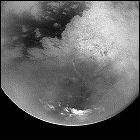 In its first close flyby of Saturn’s largest moon, the unmanned Cassini probe performs the first-ever radar reconaissance of Titan’s surface. Shrouded by a thick, organically-rich atmosphere, Titan’s surface has never been seen until now. Though scientists say that Cassini’s close pass only allows them to map 1% of the surface, the preliminary results prove to be fascinating. Titan seems, at first glance, to have a relatively smooth surface, perhaps indicating oceans, or ongoing glacial or volcanic resurfacing; a member of the radar imaging team says that readings have also indicated that the surface of Titan is “covered in organics.” Cassini will get further chances to aim its radar beams at Titan, and in December it will release the European Space Agency’s Huygens probe, which will approach Titan, ultimately entering the moon’s dense atmosphere in January to take direct readings from the surface, whether it’s solid or liquid.
In its first close flyby of Saturn’s largest moon, the unmanned Cassini probe performs the first-ever radar reconaissance of Titan’s surface. Shrouded by a thick, organically-rich atmosphere, Titan’s surface has never been seen until now. Though scientists say that Cassini’s close pass only allows them to map 1% of the surface, the preliminary results prove to be fascinating. Titan seems, at first glance, to have a relatively smooth surface, perhaps indicating oceans, or ongoing glacial or volcanic resurfacing; a member of the radar imaging team says that readings have also indicated that the surface of Titan is “covered in organics.” Cassini will get further chances to aim its radar beams at Titan, and in December it will release the European Space Agency’s Huygens probe, which will approach Titan, ultimately entering the moon’s dense atmosphere in January to take direct readings from the surface, whether it’s solid or liquid.
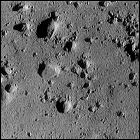 NASA’s NEAR-Shoemaker unmanned spacecraft gently touches down on the surface of asteroid 433 Eros, the first human-made space vehicle to land on such a body. Ground controllers are surprised to discover that NEAR-Shoemaker survives the landing, which was originally meant to end the mission; a two-week mission extension allows scientists to get readings from instruments that are now mere inches from Eros’ surface.
NASA’s NEAR-Shoemaker unmanned spacecraft gently touches down on the surface of asteroid 433 Eros, the first human-made space vehicle to land on such a body. Ground controllers are surprised to discover that NEAR-Shoemaker survives the landing, which was originally meant to end the mission; a two-week mission extension allows scientists to get readings from instruments that are now mere inches from Eros’ surface.
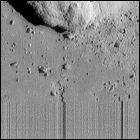 NASA’s NEAR-Shoemaker unmanned spacecraft, still on the surface of asteroid 433 Eros, sends its final signals to Earth before shutting down. Launched in 1996, NEAR-Shoemaker swung by asteroid 253 Mathilde before making its way to Eros via an Earth gravity assist maneuver. It orbited Eros for a year, having started its operations in close proximity to the asteroid a year later due to a technical problem in 1998 that nearly destroyed the space probe. Future asteroid missions such as Hayabusa and Dawn will refine the science of traveling to and studying asteroids.
NASA’s NEAR-Shoemaker unmanned spacecraft, still on the surface of asteroid 433 Eros, sends its final signals to Earth before shutting down. Launched in 1996, NEAR-Shoemaker swung by asteroid 253 Mathilde before making its way to Eros via an Earth gravity assist maneuver. It orbited Eros for a year, having started its operations in close proximity to the asteroid a year later due to a technical problem in 1998 that nearly destroyed the space probe. Future asteroid missions such as Hayabusa and Dawn will refine the science of traveling to and studying asteroids.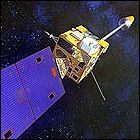 NOAA’s GOES-12 Geostationary Operational Environmental Satellite is launched from Cape Canaveral into geosynchronous orbit to monitor weather patterns over the United States. It will be held in reserve until 2003, when it will be moved to the GOES-EAST position to replace GOES-8, which is nearly out of fuel. Though GOES-11 has been in orbit longer than GOES-12, this satellite is activated first to use a solar imaging instrument (which will fail in 2006). Once in its active position, GOES-12 suffers from chronic thruster problems due to errors made during wiring of its primary and backup maneuvering thrusters; one outage will prove to be severe enough that the still-active GOES-10 must cover GOES-EAST coverage. In 2008, another thruster glitch will cause GOES-12 to temporarily lose all attitude control. In 2010, GOES-13 will replace GOES-12 in the GOES-EAST orbit thanks to the continued attitude control issues; GOES-12 remains in orbit as a backup.
NOAA’s GOES-12 Geostationary Operational Environmental Satellite is launched from Cape Canaveral into geosynchronous orbit to monitor weather patterns over the United States. It will be held in reserve until 2003, when it will be moved to the GOES-EAST position to replace GOES-8, which is nearly out of fuel. Though GOES-11 has been in orbit longer than GOES-12, this satellite is activated first to use a solar imaging instrument (which will fail in 2006). Once in its active position, GOES-12 suffers from chronic thruster problems due to errors made during wiring of its primary and backup maneuvering thrusters; one outage will prove to be severe enough that the still-active GOES-10 must cover GOES-EAST coverage. In 2008, another thruster glitch will cause GOES-12 to temporarily lose all attitude control. In 2010, GOES-13 will replace GOES-12 in the GOES-EAST orbit thanks to the continued attitude control issues; GOES-12 remains in orbit as a backup.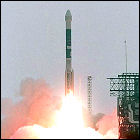 NASA and JPL launch the unmanned space probe Genesis to collect samples of the solar wind by exposing various materials from Earth to the solar wind and returning those materials to Earth – the first space mission to return samples from space since the Apollo moon missions – so the properties of the exposed samples can be compared to those of similar samples still on Earth. After nearly three years in deep space, Genesis will send a capsule loaded with these samples back to Earth, though its landing won’t exactly go as planned.
NASA and JPL launch the unmanned space probe Genesis to collect samples of the solar wind by exposing various materials from Earth to the solar wind and returning those materials to Earth – the first space mission to return samples from space since the Apollo moon missions – so the properties of the exposed samples can be compared to those of similar samples still on Earth. After nearly three years in deep space, Genesis will send a capsule loaded with these samples back to Earth, though its landing won’t exactly go as planned.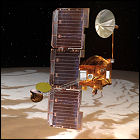 NASA’s 2001 Mars Odyssey probe reaches Mars and settles into an orbit which will gradually be corrected by aerobraking (using the friction of the planet’s atmosphere to slow the vehicle down). Unlike the Mars Surveyor mission, Odyssey does not contain a landing probe, but will instead look at the planet from orbit. Another unique feature of Odyssey’s mission plan is the fact that it won’t be shut down when its scientific investigation has come to an end; it will be left in Mars orbit to serve as a communications relay satellite for future missions.
NASA’s 2001 Mars Odyssey probe reaches Mars and settles into an orbit which will gradually be corrected by aerobraking (using the friction of the planet’s atmosphere to slow the vehicle down). Unlike the Mars Surveyor mission, Odyssey does not contain a landing probe, but will instead look at the planet from orbit. Another unique feature of Odyssey’s mission plan is the fact that it won’t be shut down when its scientific investigation has come to an end; it will be left in Mars orbit to serve as a communications relay satellite for future missions.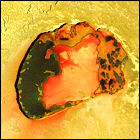 NASA/JPL’s Galileo unmanned space probe makes the closest flybys yet of Io, the volcanically hyperactive moon of Jupiter which made headlines when Voyager scientists spotted an eruption in 1980. The new images give the best view yet of Io’s inhospitable surface, including a volcanic crater, 47 miles across, named after the Brazilian god of thunder, Tupan Patera – an eye-searingly colorful region even in natural light.
NASA/JPL’s Galileo unmanned space probe makes the closest flybys yet of Io, the volcanically hyperactive moon of Jupiter which made headlines when Voyager scientists spotted an eruption in 1980. The new images give the best view yet of Io’s inhospitable surface, including a volcanic crater, 47 miles across, named after the Brazilian god of thunder, Tupan Patera – an eye-searingly colorful region even in natural light.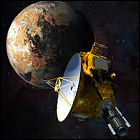 NASA announces that the New Horizons mission, proposed by a group of scientists and engineers from the cancelled Pluto-Kuiper Express mission, will go ahead to preparation, construction and launch sometime in 2006. Part of NASA’s new New Frontiers mission class, New Horizons promises significant scientific return from a never-before-explored region of the solar system while adhering to the “faster, better, cheaper” philosophy NASA has rallied around since the 1990s. Though this is the official green light for New Horizons to proceed, budget cutbacks at the Congressional level will threaten the mission for several years to come.
NASA announces that the New Horizons mission, proposed by a group of scientists and engineers from the cancelled Pluto-Kuiper Express mission, will go ahead to preparation, construction and launch sometime in 2006. Part of NASA’s new New Frontiers mission class, New Horizons promises significant scientific return from a never-before-explored region of the solar system while adhering to the “faster, better, cheaper” philosophy NASA has rallied around since the 1990s. Though this is the official green light for New Horizons to proceed, budget cutbacks at the Congressional level will threaten the mission for several years to come.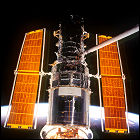 Space Shuttle Columbia lifts off on the 108th shuttle flight, the third Hubble Space Telescope servicing mission. Numerous enhancements are carried aboard the shuttle to replace existing parts on the decade-old orbiting telescope, including new cooling systems and a new set of solar power arrays. Aboard Columbia for her 27th flight are Commander Scott Altman, Pilot Duane Carey, Payload Commander John Grunsfeld, and mission specialists Nancy Currie, James Newman, Richard Linnehan and Michael Massimino.
Space Shuttle Columbia lifts off on the 108th shuttle flight, the third Hubble Space Telescope servicing mission. Numerous enhancements are carried aboard the shuttle to replace existing parts on the decade-old orbiting telescope, including new cooling systems and a new set of solar power arrays. Aboard Columbia for her 27th flight are Commander Scott Altman, Pilot Duane Carey, Payload Commander John Grunsfeld, and mission specialists Nancy Currie, James Newman, Richard Linnehan and Michael Massimino.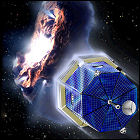 Launched on July 3rd, NASA’s comet-chasing CONTOUR (Comet Nucleus Tour) space probe fails to respond to an all-important, critically-timed command that would send it toward its first rendevous with a comet. As NASA engineers attempt to regain contact, high-powered telescopes pick up what may be a cloud of the $159,000,000 space probe’s debris as it settles into a leisurely orbit around the sun. A definitive cause for the failure of the CONTOUR mission is never found.
Launched on July 3rd, NASA’s comet-chasing CONTOUR (Comet Nucleus Tour) space probe fails to respond to an all-important, critically-timed command that would send it toward its first rendevous with a comet. As NASA engineers attempt to regain contact, high-powered telescopes pick up what may be a cloud of the $159,000,000 space probe’s debris as it settles into a leisurely orbit around the sun. A definitive cause for the failure of the CONTOUR mission is never found.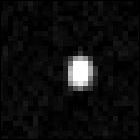 NASA’s Hubble Space Telescope spots an object beyond the orbit of Pluto, and approximately half the size of Pluto – the largest object discovered in the solar system in over 70 years. With a circular orbit that’s a billion miles further from the sun than Pluto, the body is determined to be approximately 800 miles in diameter. Quaoar is believed to be the largest Kuiper Belt object discovered to date, though its thunder will be stolen a few years later with the discovery of Eris and the demotion of Pluto to a dwarf planet.
NASA’s Hubble Space Telescope spots an object beyond the orbit of Pluto, and approximately half the size of Pluto – the largest object discovered in the solar system in over 70 years. With a circular orbit that’s a billion miles further from the sun than Pluto, the body is determined to be approximately 800 miles in diameter. Quaoar is believed to be the largest Kuiper Belt object discovered to date, though its thunder will be stolen a few years later with the discovery of Eris and the demotion of Pluto to a dwarf planet.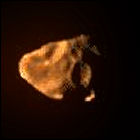 Nearing the end of its fuel supply, NASA’s Galileo probe passes one of Jupiter’s innermost moons, tiny, asteroid-like Amalthea, at a distance of less than 100 miles, coming closer to Jupiter and its belts of intense radiation than ever before. This final flyby of a Jovian moon is a punishing one for Galileo: the failure of Galileo’s main antenna dish after its 1989 launch has forced the robotic explorer to store its findings on tape for later playback to Earth at a low bit rate, but in this case roughly half of Galileo’s measurements of the highly charged environment near Jupiter are lost to radiation-induced failure of the tape recording system. The intense radiation also causes enough faults in Galileo’s main computer that the probe puts itself in a failsafe mode and “sleeps” until further commands are received from Earth hours later.
Nearing the end of its fuel supply, NASA’s Galileo probe passes one of Jupiter’s innermost moons, tiny, asteroid-like Amalthea, at a distance of less than 100 miles, coming closer to Jupiter and its belts of intense radiation than ever before. This final flyby of a Jovian moon is a punishing one for Galileo: the failure of Galileo’s main antenna dish after its 1989 launch has forced the robotic explorer to store its findings on tape for later playback to Earth at a low bit rate, but in this case roughly half of Galileo’s measurements of the highly charged environment near Jupiter are lost to radiation-induced failure of the tape recording system. The intense radiation also causes enough faults in Galileo’s main computer that the probe puts itself in a failsafe mode and “sleeps” until further commands are received from Earth hours later.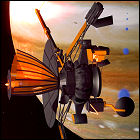 NASA and JPL ground controllers coax the radiation-damaged tape recorder built into the Galileo probe into working again, finally allowing several weeks worth of scientific data to be replayed to Earth. The damage was suffered during Galileo’s closest pass by Jupiter to study the tiny moon Amalthea the previous month. With layoffs looming for many of Galileo’s ground control staff in early 2003, this is Galileo’s last chance to relay its scientific findings back to Earth. It is on a trajectory that will end its mission by plunging into Jupiter in 2003.
NASA and JPL ground controllers coax the radiation-damaged tape recorder built into the Galileo probe into working again, finally allowing several weeks worth of scientific data to be replayed to Earth. The damage was suffered during Galileo’s closest pass by Jupiter to study the tiny moon Amalthea the previous month. With layoffs looming for many of Galileo’s ground control staff in early 2003, this is Galileo’s last chance to relay its scientific findings back to Earth. It is on a trajectory that will end its mission by plunging into Jupiter in 2003.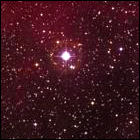 NASA’s Hubble Space Telescope makes an astonishing discovery while observing one of the first planets discovered beyond Earth’s solar system. The gas giant planet designated HD 209458b, orbiting the star HD 209458 in the constellation of Pegasus, 150 light years from Earth, is losing its atmosphere. Slightly larger than Jupiter, but locked into a dizzyingly tight orbit around its star (only 4,000,000 miles, with its “year” lasting less than half of an Earth week), HD 209458b’s atmosphere is boiling away into space thanks to the heat of the nearby star. This leads to a new exoplanet classification, “Hot Jupiters,” used to describe gas giants in similarly suicidal orbits. The core of HD 209458b will probably not last long once the last remnants of its atmosphere dissipate.
NASA’s Hubble Space Telescope makes an astonishing discovery while observing one of the first planets discovered beyond Earth’s solar system. The gas giant planet designated HD 209458b, orbiting the star HD 209458 in the constellation of Pegasus, 150 light years from Earth, is losing its atmosphere. Slightly larger than Jupiter, but locked into a dizzyingly tight orbit around its star (only 4,000,000 miles, with its “year” lasting less than half of an Earth week), HD 209458b’s atmosphere is boiling away into space thanks to the heat of the nearby star. This leads to a new exoplanet classification, “Hot Jupiters,” used to describe gas giants in similarly suicidal orbits. The core of HD 209458b will probably not last long once the last remnants of its atmosphere dissipate.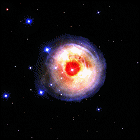 Following up on observations from Earth-based telescopes, NASA’s Hubble Space Telescope is pointed toward the star V838 Monocerotis – an object of very little previous interest – to discover why it’s suddenly the brightest thing in the entire Milky Way Galaxy. What Hubble sees surprises scientists on the ground: a “shell” of matter surrounding the star, illuminated from within and expanding outward into space (actual photo sequence seen here). What astronomers had seen previously was the illumination of the dust cloud, which is much larger than the star itself. Scientists theorize that the expanding dust cloud is not an indication of a supernova, but a sign that V838 Monocerotis is expanding, expelling gas and then shrinking again. The star is over 20,000 light years from Earth.
Following up on observations from Earth-based telescopes, NASA’s Hubble Space Telescope is pointed toward the star V838 Monocerotis – an object of very little previous interest – to discover why it’s suddenly the brightest thing in the entire Milky Way Galaxy. What Hubble sees surprises scientists on the ground: a “shell” of matter surrounding the star, illuminated from within and expanding outward into space (actual photo sequence seen here). What astronomers had seen previously was the illumination of the dust cloud, which is much larger than the star itself. Scientists theorize that the expanding dust cloud is not an indication of a supernova, but a sign that V838 Monocerotis is expanding, expelling gas and then shrinking again. The star is over 20,000 light years from Earth.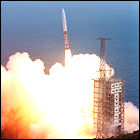 Japan’s Institute of Space and Astronautical Science (ISAS), launches the unmanned Hayabusa space probe on a mission to gather material from asteroid 25143 Itokawa. Intended to reach Itokawa in two years, and then return the asteroid samples to Earth in 2010, Hayabusa will also attempt to drop a small rover on Itokawa’s surface and will test an ion engine propulsion system. The name “Hayabusa” – translating to “peregrine falcon” – is only bestowed upon the spacecraft once it reaches space; prior to that, Hayabusa is known by its engineering designation, MUSES-C. A few months after Hayabusa’s launch, ISAS itself is renamed JAXA (the Japanese Aerospace Exploration Agency).
Japan’s Institute of Space and Astronautical Science (ISAS), launches the unmanned Hayabusa space probe on a mission to gather material from asteroid 25143 Itokawa. Intended to reach Itokawa in two years, and then return the asteroid samples to Earth in 2010, Hayabusa will also attempt to drop a small rover on Itokawa’s surface and will test an ion engine propulsion system. The name “Hayabusa” – translating to “peregrine falcon” – is only bestowed upon the spacecraft once it reaches space; prior to that, Hayabusa is known by its engineering designation, MUSES-C. A few months after Hayabusa’s launch, ISAS itself is renamed JAXA (the Japanese Aerospace Exploration Agency).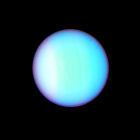 Astronomers using the Hubble Space Telescope discover two new moons of Uranus that eluded detection during Voyager 2’s 1986 flyby: Cupid and Mab. Both small, dark bodies that orbit closer to Uranus than any of the planet’s large satellites, Cupid and Mab raise the number of known Uranian satellites above 20. Mab’s orbit keeps it within the planet’s outermost ring, while Cupid’s orbit is only 500 miles further out than that of Belinda, one of the small moons discovered in 1986 by Voyager 2. Cupid is the tiniest of the inner moons of Uranus, roughly 11 miles in diameter.
Astronomers using the Hubble Space Telescope discover two new moons of Uranus that eluded detection during Voyager 2’s 1986 flyby: Cupid and Mab. Both small, dark bodies that orbit closer to Uranus than any of the planet’s large satellites, Cupid and Mab raise the number of known Uranian satellites above 20. Mab’s orbit keeps it within the planet’s outermost ring, while Cupid’s orbit is only 500 miles further out than that of Belinda, one of the small moons discovered in 1986 by Voyager 2. Cupid is the tiniest of the inner moons of Uranus, roughly 11 miles in diameter.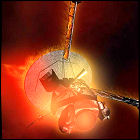 The mission of the unmanned space probe Galileo ends in the clouds of the giant planet Jupiter, which it has orbited for eight years. Even as Galileo plunges toward Jupiter, it detects and reports evidence of a thin ring sharing the orbit of the small moon Amalthea, and then disintegrates as it falls into Jupiter. NASA has opted to send Galileo to its destruction, rather than risking a collision with Europa, which may harbor some of the ingredients necessary for life and might be contaminated if Galileo impacted it; Galileo’s mission was extended three times, with the vehicle lasting six years longer than anticipated in the original mission plan’s estimates, which included for the harsh radiation environment of Jupiter as a factor in expecting only a two-year mission.
The mission of the unmanned space probe Galileo ends in the clouds of the giant planet Jupiter, which it has orbited for eight years. Even as Galileo plunges toward Jupiter, it detects and reports evidence of a thin ring sharing the orbit of the small moon Amalthea, and then disintegrates as it falls into Jupiter. NASA has opted to send Galileo to its destruction, rather than risking a collision with Europa, which may harbor some of the ingredients necessary for life and might be contaminated if Galileo impacted it; Galileo’s mission was extended three times, with the vehicle lasting six years longer than anticipated in the original mission plan’s estimates, which included for the harsh radiation environment of Jupiter as a factor in expecting only a two-year mission.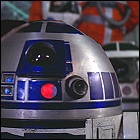
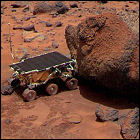 The first four inductees – two real and two fictional – are inducted into the Robot Hall Of Fame created by Carnegie Mellon University’s School of Computer Science.
The first four inductees – two real and two fictional – are inducted into the Robot Hall Of Fame created by Carnegie Mellon University’s School of Computer Science.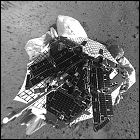 The first of two new American Mars rovers lands successfully on the red planet. The Mars rover Spirit enters the Martian atmosphere (and cleaves a path right through a dust storm), deploying thick layers of airbags that allow it to bounce safely until landing upright. This is the same landing system employed by the Pathfinder mission in 1997, but the unmanned robot probe in this case is much more sophisticated. Among the primary scientific objectives of Spirit’s mission is to determine if water existed on the surface of Mars for a significant length of time. The Spirit rover will undergo a series of diagnostics and won’t begin its mobile mission for several days. Its identical twin, a rover named Opportunity, will land in three weeks.
The first of two new American Mars rovers lands successfully on the red planet. The Mars rover Spirit enters the Martian atmosphere (and cleaves a path right through a dust storm), deploying thick layers of airbags that allow it to bounce safely until landing upright. This is the same landing system employed by the Pathfinder mission in 1997, but the unmanned robot probe in this case is much more sophisticated. Among the primary scientific objectives of Spirit’s mission is to determine if water existed on the surface of Mars for a significant length of time. The Spirit rover will undergo a series of diagnostics and won’t begin its mobile mission for several days. Its identical twin, a rover named Opportunity, will land in three weeks.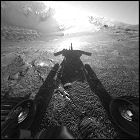 The Opportunity rover, identical to Spirit, lands on schedule and on target in Mars’ Meridiani Planum region, but initial readings from the surface of Mars indicate that the landing pod containing Opportunity has come to rest on its side. Telemetry signals from Opportunity announce that the the rover has arrived safely and intact, ready to begin its mission, and the opening of the landing vehicle returns Opportunity to its intended upright position. As with Spirit, Opportunity will remain on its landing platform for several days undergoing a series of diagnostic tests before rolling off to the Martian surface for independent exploration, and engineers are keeping a close eye out for signs of a computer problem that has plagued Spirit for several days.
The Opportunity rover, identical to Spirit, lands on schedule and on target in Mars’ Meridiani Planum region, but initial readings from the surface of Mars indicate that the landing pod containing Opportunity has come to rest on its side. Telemetry signals from Opportunity announce that the the rover has arrived safely and intact, ready to begin its mission, and the opening of the landing vehicle returns Opportunity to its intended upright position. As with Spirit, Opportunity will remain on its landing platform for several days undergoing a series of diagnostic tests before rolling off to the Martian surface for independent exploration, and engineers are keeping a close eye out for signs of a computer problem that has plagued Spirit for several days.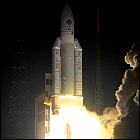 After years of delays that forced a rewrite of the entire mission plan, the European Space Agency launches the Rosetta unmanned space probe on a looping, ten-year journey through the solar system that will hopefully take it to a rendezvous with Comet 67/P Churyumov–Gerasimenko in ten years. The mission plan calls for Rosetta to orbit the comet and release a small lander, Philae, to descend to its surface. In the intervening years, Rosetta will also have opportunities to study Mars and various asteroids as it passes by them. Rosetta’s mission profile is similar to that of NASA’s cancelled 1990s CRAF (Comet Rendezvous / Asteroid Flyby) mission.
After years of delays that forced a rewrite of the entire mission plan, the European Space Agency launches the Rosetta unmanned space probe on a looping, ten-year journey through the solar system that will hopefully take it to a rendezvous with Comet 67/P Churyumov–Gerasimenko in ten years. The mission plan calls for Rosetta to orbit the comet and release a small lander, Philae, to descend to its surface. In the intervening years, Rosetta will also have opportunities to study Mars and various asteroids as it passes by them. Rosetta’s mission profile is similar to that of NASA’s cancelled 1990s CRAF (Comet Rendezvous / Asteroid Flyby) mission.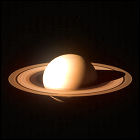 The Cassini spacecraft is close enough to Saturn to observe unusual transitory “clumps” in the planet’s ring system. First spotted by the Voyager space probes in the early 1980s, these clumps zip around Saturn’s outermost rings, following the direction of the planet’s own motion, but until now it hasn’t been possible to get close enough to study those clumps. Unlike the Voyagers, however, Cassini won’t be zipping past the planet at the speed of a bullet – it will enter an orbit around the planet in July and keep an eye on things.
The Cassini spacecraft is close enough to Saturn to observe unusual transitory “clumps” in the planet’s ring system. First spotted by the Voyager space probes in the early 1980s, these clumps zip around Saturn’s outermost rings, following the direction of the planet’s own motion, but until now it hasn’t been possible to get close enough to study those clumps. Unlike the Voyagers, however, Cassini won’t be zipping past the planet at the speed of a bullet – it will enter an orbit around the planet in July and keep an eye on things.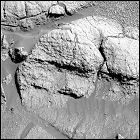 NASA scientists unveil new findings from the two Mars Exploration Rovers, Spirit and Opportunity. While both rovers have found evidence of water erosion in rocks at their respective landing sites, the scientists now say that Opportunity’s landing site – a large crater – features rocks which show conclusive evidence of a large body of salt water, not unlike Earth’s oceans. While no definitive signs of life have been found by Opportunity or its identical twin, these findings continue to add up to a picture of Mars as a place where life once could have thrived.
NASA scientists unveil new findings from the two Mars Exploration Rovers, Spirit and Opportunity. While both rovers have found evidence of water erosion in rocks at their respective landing sites, the scientists now say that Opportunity’s landing site – a large crater – features rocks which show conclusive evidence of a large body of salt water, not unlike Earth’s oceans. While no definitive signs of life have been found by Opportunity or its identical twin, these findings continue to add up to a picture of Mars as a place where life once could have thrived. 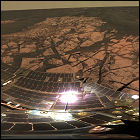 NASA announces that the Spirit rover has exceeded its mission goals of 90 continuous Martian days of operation since landing, with over 600 meters of the Martian surface covered. NASA applies for, and receives approval on, a plan to keep Spirit and Opportunity roving through September, almost tripling the rovers’ planned life span. The extended mission, made possible by a budget boost of $15 million, will give engineers the chance to try handing control over to the Rovers’ built-in systems, and it’ll afford a greater opportunity to examine the unusual rocks and evidence of past bodies of water on the Martian surface.
NASA announces that the Spirit rover has exceeded its mission goals of 90 continuous Martian days of operation since landing, with over 600 meters of the Martian surface covered. NASA applies for, and receives approval on, a plan to keep Spirit and Opportunity roving through September, almost tripling the rovers’ planned life span. The extended mission, made possible by a budget boost of $15 million, will give engineers the chance to try handing control over to the Rovers’ built-in systems, and it’ll afford a greater opportunity to examine the unusual rocks and evidence of past bodies of water on the Martian surface.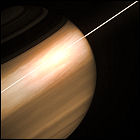 After a journey of seven years, gravity-assist slingshots past Earth, Venus and Jupiter, a plunge through Saturn’s ring-plane, and an engine burn of over an hour just to slow it down, the NASA/ESA space probe Cassini becomes the first man-made object to orbit Saturn. The trip has already paid off: Cassini has spotted never-before-seen features in Saturn’s immense rings, and succeeds in piercing Titan’s atmosphere with infrared imaging to provide one of the first-ever glimpses of the huge moon’s cloud-covered surface. Titan will also receive a visit from Cassini’s Huygens probe in 2005.
After a journey of seven years, gravity-assist slingshots past Earth, Venus and Jupiter, a plunge through Saturn’s ring-plane, and an engine burn of over an hour just to slow it down, the NASA/ESA space probe Cassini becomes the first man-made object to orbit Saturn. The trip has already paid off: Cassini has spotted never-before-seen features in Saturn’s immense rings, and succeeds in piercing Titan’s atmosphere with infrared imaging to provide one of the first-ever glimpses of the huge moon’s cloud-covered surface. Titan will also receive a visit from Cassini’s Huygens probe in 2005.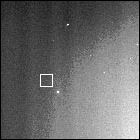 Mere weeks after entering orbit around the huge ringed planet, the Cassini is already making impressive discoveries at Saturn. NASA announces that Cassini images have uncovered two previously undiscovered moons in orbit of the ringed planet, and they’re among the smallest bodies that have yet been detected in space, each barely 2 miles in diameter. They’re given the provisional names s/2004 S1 and s/2004 S2, and await further verification of their size and orbits – and undoubtedly other members of Saturn’s family are waiting to be captured by Cassini’s cameras in the course of its planned four-year survey of the planet and its moons.
Mere weeks after entering orbit around the huge ringed planet, the Cassini is already making impressive discoveries at Saturn. NASA announces that Cassini images have uncovered two previously undiscovered moons in orbit of the ringed planet, and they’re among the smallest bodies that have yet been detected in space, each barely 2 miles in diameter. They’re given the provisional names s/2004 S1 and s/2004 S2, and await further verification of their size and orbits – and undoubtedly other members of Saturn’s family are waiting to be captured by Cassini’s cameras in the course of its planned four-year survey of the planet and its moons. 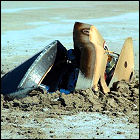 The NASA/JPL Genesis mission, a 29-month trek through the solar system to gather solar particles and return them to Earth, ends in disaster when both of the parachutes – meant to slow the returning Genesis capsule down and give retrieval helicopters something to hook onto to bring the capsule to the ground safely – fail to open. As a result, the 420+ pound Genesis capsule slams into the Utah desert floor at nearly 200 miles per hour. The impact breaches not only the outer re-entry shell of the capsule, but the experiment canister within containing the fragile plates of gold, sapphire, diamond and other pure substances, all of which had been exposed to the solar wind to collect particles from the sun. Scientists begin picking through the debris to see what portions of those collection devices can be salvaged. Several pieces of the collection devices are salvageable, with at least two complete plates and fragments of several others, but many other plates are reduced to dust by the impact of landing.
The NASA/JPL Genesis mission, a 29-month trek through the solar system to gather solar particles and return them to Earth, ends in disaster when both of the parachutes – meant to slow the returning Genesis capsule down and give retrieval helicopters something to hook onto to bring the capsule to the ground safely – fail to open. As a result, the 420+ pound Genesis capsule slams into the Utah desert floor at nearly 200 miles per hour. The impact breaches not only the outer re-entry shell of the capsule, but the experiment canister within containing the fragile plates of gold, sapphire, diamond and other pure substances, all of which had been exposed to the solar wind to collect particles from the sun. Scientists begin picking through the debris to see what portions of those collection devices can be salvaged. Several pieces of the collection devices are salvageable, with at least two complete plates and fragments of several others, but many other plates are reduced to dust by the impact of landing.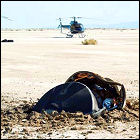 A week after the Genesis sample return mission tumbled back to Earth, slamming into the Utah desert floor at nearly 200 miles per hour after its parachutes failed to open, investigators find a likely cause of the crash. It appears that four gravity-sensitive switches, designed to sense the sudden deceleration of the Genesis capsule through Earth’s atmosphere and set off a timed sequence that would’ve opened the parachutes, had all been installed backwards. The four switches were designed to be redundant, so that if some failed the others could still carry out their assigned task…but this doesn’t do a lot of good if all of them are all installed incorrrectly. The investigation indicates that an erroneous schematic diagram of Genesis may be to blame. In the meantime, researchers begin to examine the surviving chunks of the broken collector plates containing particles of solar material.
A week after the Genesis sample return mission tumbled back to Earth, slamming into the Utah desert floor at nearly 200 miles per hour after its parachutes failed to open, investigators find a likely cause of the crash. It appears that four gravity-sensitive switches, designed to sense the sudden deceleration of the Genesis capsule through Earth’s atmosphere and set off a timed sequence that would’ve opened the parachutes, had all been installed backwards. The four switches were designed to be redundant, so that if some failed the others could still carry out their assigned task…but this doesn’t do a lot of good if all of them are all installed incorrrectly. The investigation indicates that an erroneous schematic diagram of Genesis may be to blame. In the meantime, researchers begin to examine the surviving chunks of the broken collector plates containing particles of solar material. In its first close flyby of Saturn’s largest moon, the unmanned Cassini probe performs the first-ever radar reconaissance of Titan’s surface. Shrouded by a thick, organically-rich atmosphere, Titan’s surface has never been seen until now. Though scientists say that Cassini’s close pass only allows them to map 1% of the surface, the preliminary results prove to be fascinating. Titan seems, at first glance, to have a relatively smooth surface, perhaps indicating oceans, or ongoing glacial or volcanic resurfacing; a member of the radar imaging team says that readings have also indicated that the surface of Titan is “covered in organics.” Cassini will get further chances to aim its radar beams at Titan, and in December it will release the European Space Agency’s Huygens probe, which will approach Titan, ultimately entering the moon’s dense atmosphere in January to take direct readings from the surface, whether it’s solid or liquid.
In its first close flyby of Saturn’s largest moon, the unmanned Cassini probe performs the first-ever radar reconaissance of Titan’s surface. Shrouded by a thick, organically-rich atmosphere, Titan’s surface has never been seen until now. Though scientists say that Cassini’s close pass only allows them to map 1% of the surface, the preliminary results prove to be fascinating. Titan seems, at first glance, to have a relatively smooth surface, perhaps indicating oceans, or ongoing glacial or volcanic resurfacing; a member of the radar imaging team says that readings have also indicated that the surface of Titan is “covered in organics.” Cassini will get further chances to aim its radar beams at Titan, and in December it will release the European Space Agency’s Huygens probe, which will approach Titan, ultimately entering the moon’s dense atmosphere in January to take direct readings from the surface, whether it’s solid or liquid.